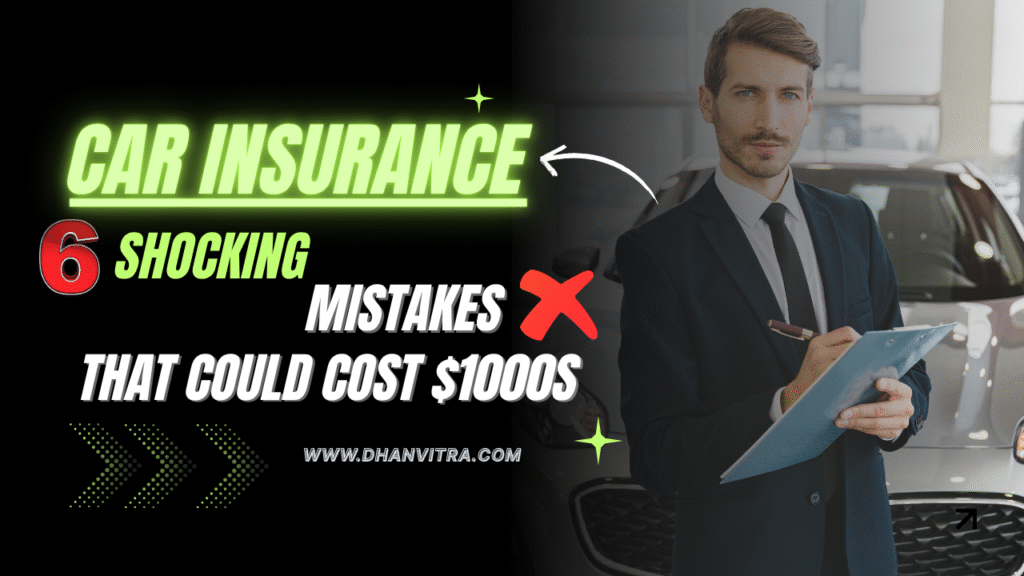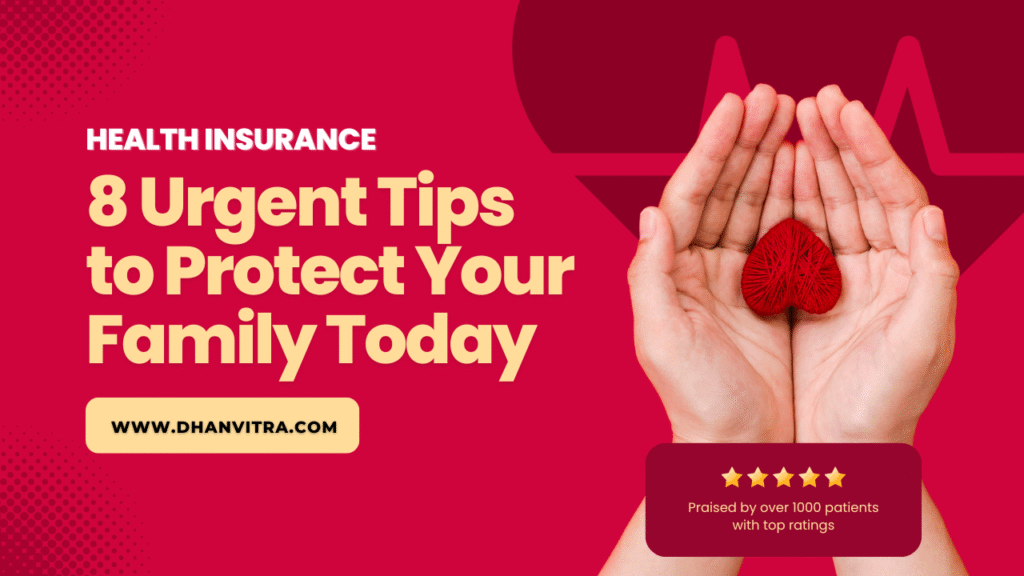
At Dhanvitra, we believe money should work for you, not against you. Whether you’re saving, investing, or protecting what you own, our goal is simple — to make finance easy to understand for everyone.
Today, let’s talk about something most drivers overlook until it’s too late — car insurance mistakes. Sounds boring? Trust me, it’s not. These tiny slip-ups can quietly drain your bank account, sometimes costing you $1000s in unnecessary expenses.
Think about it — you pay your premiums on time, you feel “covered,” but when an accident happens, your insurer says, “Sorry, that’s not included.” Frustrating, right? That’s exactly what this article will help you avoid.
In this Dhanvitra guide, we’ll uncover six shocking car insurance mistakes that even smart people make — like skipping comprehensive coverage or ignoring renewal dates. We’ll break down each one in simple terms, share real-world examples, and show you how to fix them before they cost you a fortune.
Whether you’re buying a new car, renewing your policy, or just curious about saving more on premiums, this post is for you. No jargon, no fluff — just clear, useful advice that could save you a lot of money.
So, please grab a cup of coffee, sit back, and let’s dive in. By the end, you’ll know exactly how to protect your car, your wallet, and your peace of mind.
Mistake #1 – Choosing the Cheapest Policy Without Reading the Fine Print
Let’s be honest — who doesn’t love saving money? When you see a car insurance policy that’s cheaper than the rest, it’s tempting to grab it right away. But here’s the problem: the cheapest plan often hides some expensive surprises.
Many drivers focus only on the premium amount and forget to read the fine print. That small section you skip? It often contains the real deal — what’s included, what’s excluded, and how much you’ll actually pay during a claim.
For instance, some low-cost plans may exclude flood damage, theft, or personal injury protection. So, you think you’re saving $100 a year, but if your car gets stolen or damaged by a natural disaster, you could be facing a repair bill of $5,000 or more — all out of pocket.
It’s like buying a budget umbrella that snaps during the first storm. Cheap upfront, costly later.
The smarter move? Compare policies based on coverage quality, not just price. Look at factors like claim settlement ratio, add-ons, and customer reviews. Remember, the best car insurance isn’t the cheapest — it’s the one that actually protects you when things go wrong.
Mistake #2 – Skipping Comprehensive Coverage
You might think, “I’m a safe driver, so why pay extra for comprehensive coverage?” That’s a common thought — and a costly one.
Comprehensive car insurance doesn’t just protect you from accidents. It also covers things beyond your control — theft, fire, vandalism, natural disasters, and even animal damage. Without it, you’re on your own when your car gets scratched in a parking lot or damaged in a storm.
Imagine waking up to find your windshield shattered after a hailstorm. If you only have third-party insurance, you’ll be the one paying for the repairs. That’s why skipping comprehensive coverage can backfire big time.
Even if your car is older, consider at least partial coverage for things like fire or theft. You never know when something unexpected might happen.
Think of comprehensive coverage as your car’s all-weather jacket. It costs a little more, but it keeps you safe from life’s unpredictable messes.
Mistake #3 – Ignoring Policy Renewal Dates
We all get busy. Between work, travel, and family life, it’s easy to forget small things — like your car insurance renewal date. But missing that date, even by a day, can be a huge mistake.
When your car insurance lapses, your coverage stops instantly. If you meet with an accident during that gap, you’ll have to pay for the damages yourself. And when you renew later, you might face higher premiums because insurers often treat you as a new customer with no “continuous coverage” record.
In some countries, driving without valid insurance can even get your car seized or your license suspended. It’s simply not worth the risk.
The easiest fix? Set reminders on your phone or opt for auto-renewal. Most insurers now offer digital renewals that take less than five minutes. Staying insured isn’t just smart — it’s essential for your financial safety.
So, next time you get that “renew now” message, don’t swipe it away. That one click could save you thousands.
Mistake #4 – Not Updating Your Personal Information
Here’s a mistake that many drivers don’t even realize they’re making — not updating their personal details after major life changes.
Your car insurance premium is based on personal information, such as your address, occupation, and driving history. If you move to a new city, start working from home, or change how often you drive, your risk profile changes too. And if your insurer doesn’t know about it, your policy might not reflect your real situation.
For example, moving from a high-traffic city to a quieter town could actually lower your insurance costs. But if you forget to update your address, you’ll keep paying the higher premium. Worse, if you file a claim with outdated details, the insurer could delay or even reject it — simply because your records don’t match.
Think of your policy as a living document. Every time something in your life changes — your car, address, or even your commute distance — update it. It takes a few minutes, but it can save you a lot of stress (and money) later.
In short, honest and up-to-date information keeps your coverage accurate and your claims safe. Transparency with your insurer is always cheaper than facing claim rejection later.
Mistake #5 – Failing to Shop Around at Renewal Time
Here’s a truth that surprises many drivers — loyalty doesn’t always pay in the insurance world. You might think sticking with the same insurer year after year earns you special treatment. Sadly, it often doesn’t. Instead, your premium might slowly creep up each renewal cycle without you even realizing it.
When your car insurance renewal notice arrives, it’s easy to just click renew and move on. But if you never compare quotes, you could be missing out on better deals. Different insurers adjust their prices based on new risk data, competitor rates, or even market trends. What was once the best price last year might not be competitive today.
Think of it like shopping for a smartphone. You wouldn’t buy the first model you see, right? The same goes for insurance. A little research before renewing can save you hundreds — sometimes even thousands — of dollars a year.
It’s smart to start checking other options about a month before your policy ends. Use trusted online comparison tools or contact insurance agents directly. Compare not just the price but also the coverage, claim process, and customer reviews. You might find a policy that offers broader protection at a lower cost.
And here’s another pro tip — if you mention you’re thinking about switching, your current insurer might offer a loyalty discount to keep you. Either way, you win. The key takeaway: never auto-renew blindly. Shopping around is the simplest way to save money and get better coverage.
Mistake #6 – Overlooking the Deductible Trap
Deductibles sound simple, but they’re one of the most misunderstood parts of car insurance. In plain terms, a deductible is the amount you pay out of pocket before your insurer covers the rest. Many people choose higher deductibles to lower their premiums. That seems smart—until an accident happens.
Let’s say you pick a $1,000 deductible because it saves you $15 a month. Sounds fine, right? But what if you get into a fender bender that costs $1,200 to repair? You’ll end up paying almost the full amount yourself. That’s not saving—it’s risk-taking.
A low premium doesn’t help much if you can’t afford the deductible when you need it. So, the trick is to find a balance. Choose a deductible that makes your premium manageable but still fits your emergency budget. If you can comfortably afford to pay $500 in case of an accident, that’s your sweet spot.
This mistake hits global drivers alike. Whether you’re in the U.S., the U.K., or Australia, the same rule applies — don’t set your deductible higher than what you can realistically pay. Car repairs aren’t cheap anywhere, and insurance is meant to give you peace of mind, not financial stress.
So, before finalizing your next policy, double-check your deductible. Don’t fall for the lower-premium illusion. A balanced policy is always the safer bet.
Bonus Tip – Not Understanding Add-Ons and Riders
Add-ons and riders are like bonus features for your insurance. They might sound fancy or unnecessary, but the right ones can make a huge difference when things go wrong. Unfortunately, many drivers skip them because they don’t know what they do—or assume they’re a waste of money.
Let’s clear that up. Add-ons are optional coverages that enhance your main policy. Think of them as customizing your insurance to fit your lifestyle. For example, zero depreciation cover ensures you get the full claim amount for damaged parts without deduction for wear and tear. Roadside assistance can be a lifesaver during a breakdown. And engine protection is great for flood-prone areas, where water damage can ruin your car’s engine.
Without these riders, you might end up paying big out-of-pocket expenses later. Imagine being stranded on a highway or facing a total engine replacement—these aren’t rare scenarios.
The smart move? Review your driving habits and location before selecting add-ons. If you live in a city with heavy traffic, roadside assistance and zero depreciation are worth every penny. If your area has unpredictable weather, engine protection or windshield cover makes sense.
Add-ons might slightly increase your premium, but they can save you thousands when accidents strike. Don’t skip them just to save a few bucks. Instead, choose the ones that truly match your needs.
How to Choose the Right Car Insurance Plan
Picking the perfect car insurance plan doesn’t have to be confusing. The best policy is one that gives you strong protection, easy claims, and fair pricing. Start by asking yourself what you actually need. Are you driving daily in busy city traffic, or occasionally on weekends? The answer helps you decide between basic and comprehensive coverage.
Next, research multiple insurers. Don’t settle for the first quote. Compare their claim settlement ratio—that’s the percentage of claims they actually pay. The higher the ratio, the more reliable the insurer. Also, check online reviews for feedback on customer support. A good insurer won’t just sell you a policy; they’ll stand by you when things go wrong.
Look at available add-ons and see which ones fit your life. If you’re in a region prone to floods or theft, comprehensive coverage with additional protection is a must. And remember to keep your deductible balanced. A lower deductible means higher premiums, but it also means less financial pressure in an emergency.
Finally, read the policy documents carefully. Don’t skip the fine print—it’s where insurers hide exclusions that could affect your claim. Understanding every clause helps you avoid unpleasant surprises later.
The right car insurance plan isn’t always the cheapest or the most expensive—it’s the one that protects you completely, gives you peace of mind, and fits your budget. So take your time, compare wisely, and choose smartly.
Expert Tips to Save Money on Car Insurance
Let’s be honest—car insurance can feel like a never-ending expense. But here’s the good news: you can actually cut your car insurance costs without sacrificing coverage. The trick lies in being smart, proactive, and a little bit strategic.
First, drive safely—always. Insurers love low-risk drivers. If you maintain a clean driving record for a few years, your premiums can drop significantly. Even one accident or speeding ticket can raise your rates for years, so careful driving really pays off.
Another smart move is to bundle your policies. If you have home, health, or life insurance, buy them from the same provider. Many insurance companies offer attractive discounts when you combine multiple policies. It’s like getting a loyalty reward for being organized.
Then there’s the anti-theft advantage. Installing devices such as GPS trackers, dashcams, or car alarms can lower your risk profile. Insurers see this as a sign of responsibility—and they reward it with lower premiums.
You can also pay annually instead of monthly. It might seem like a big upfront cost, but it often saves you processing or installment fees. And if you’re comfortable paying online, many companies even offer digital payment discounts.
Here’s another often-overlooked secret: review your policy every year. Your lifestyle changes—maybe you drive less now or have moved to a safer neighborhood. Updating this info can reduce your premium instantly. Don’t just renew automatically; compare and negotiate.
Finally, don’t underestimate the power of good credit. Yes, in many countries, your credit score affects your insurance rate. Pay your bills on time, keep your credit utilization low, and watch how your premiums drop.
Saving money on car insurance isn’t about luck—it’s about knowing the system and playing it smart.
The Global Perspective: Car Insurance Mistakes Around the World
Car insurance mistakes aren’t just a local issue—they happen everywhere. Whether you drive through the streets of New York, London, Sydney, or Mumbai, the same patterns appear, just in different forms.
In the United States, many drivers skip gap insurance when they buy new cars. When a car depreciates fast and gets totaled, the payout might be less than the loan amount. Without gap coverage, you pay the difference out of pocket. It’s a painful mistake many regret too late.
Across the United Kingdom, a common error is auto-renewal without checking prices. Many insurers increase renewal rates silently, and drivers end up paying 20–30% more for the same coverage. UK regulators even warn against blind renewals, urging consumers to switch annually for better deals.
In India, people often choose third-party insurance only, believing it’s enough because it’s legally required. But without comprehensive coverage, they’re exposed to theft, floods, and total loss. One major accident can wipe out their savings.
Meanwhile, in Australia, drivers often forget to update their insurance after moving or changing cars. A small change in address or vehicle type can completely alter your risk profile. Providing outdated details can even invalidate claims.
And in many European countries, people underestimate the value of add-ons like roadside assistance or personal accident cover. When something goes wrong abroad, these small extras can save you thousands in emergency expenses.
The lesson? No matter where you live, staying informed is your best defense. Each country has different insurance rules, but one truth remains universal: a little attention today can save you a fortune tomorrow.
Conclusion
Car insurance is more than just paperwork—it’s your financial safety net. But too often, small mistakes turn into big money problems. Choosing the cheapest plan, ignoring policy updates, or forgetting to compare rates can quietly cost you thousands over time.
The good news? You can change that starting today. Take a few minutes to review your policy, check for missing coverage, and explore better options. Ask questions. Understand your deductibles. Update your details.
And most importantly, treat car insurance as a partnership—not a formality. When you stay alert and informed, you’re not just protecting your car—you’re protecting your hard-earned money.
FAQs
What’s the easiest way to lower my car insurance cost?
Drive safely, compare policies regularly, and ask for discounts. Insurers often offer lower rates if you bundle policies or install safety devices.
Should I always go for full coverage?
Not always. If your car is old and its value is low, full coverage might not be worth it. But for new or high-value cars, it’s essential.
How often should I review my car insurance policy?
Once a year is ideal. Review it whenever your driving habits, location, or vehicle changes.
Can I switch insurance companies mid-policy?
Yes, most insurers allow you to switch anytime. Just check for cancellation fees or pending refunds before making the move.
Does credit score really affect car insurance premiums?
In many countries, yes. A higher credit score shows financial responsibility, which can lead to better rates from insurers.





